During our winter stay in Seefeld, we couldn’t resist exploring the nearby Mittenwald region. With its picture-perfect town and network of hiking trails, it turned our vacation into a proper mountain adventure.
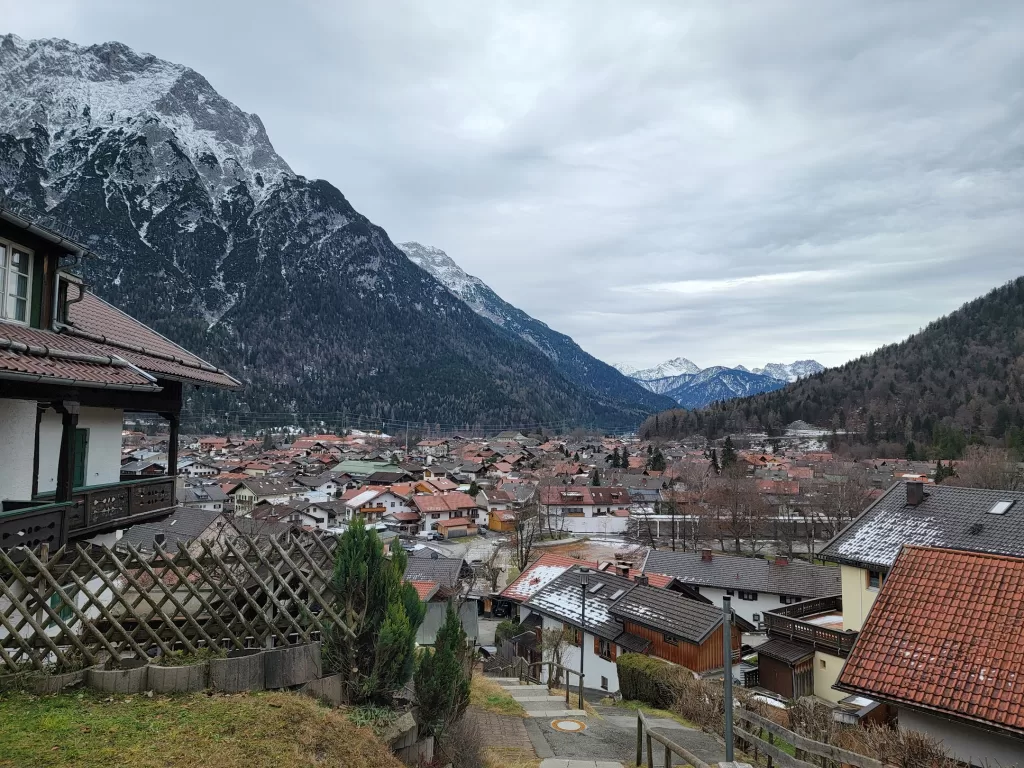
Mittenwald: Where Painted Houses Meet Mountain Peaks
Mittenwald is one of those towns that makes you wonder if you’ve somehow wandered onto a movie set. Nestled in the Bavarian Alps right by the Austrian border, this small German town is known for its beautifully painted houses (Lüftlmalerei) and violin-making tradition. But what caught my eye immediately were the mountains that seem to rise directly from the edges of town – they don’t gradually build up, they just BAM! shoot into the sky.
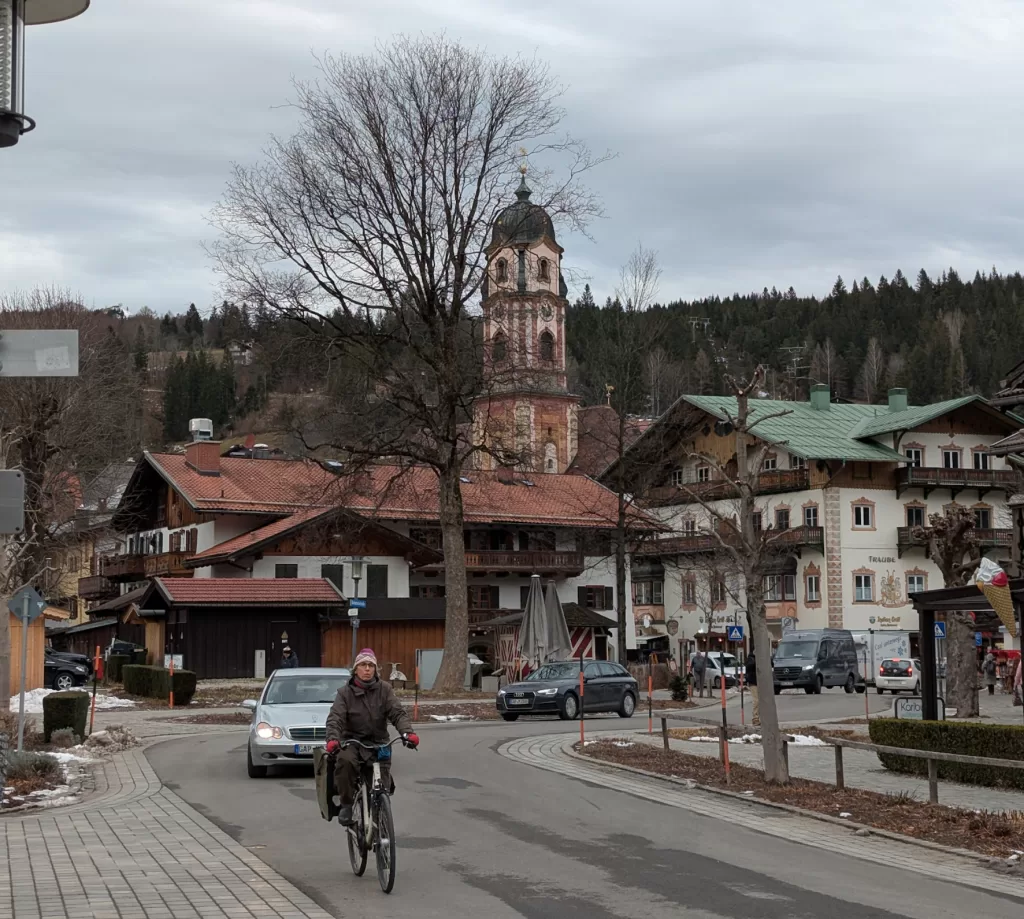
Our first hiking day started in the town center, where we grabbed some fresh pretzels for energy before heading toward Hohen Kranzberg.
The Climb to Hohen Kranzberg
The trail began innocently enough with a gentle forest path, but soon transformed into a proper mountain climb. As someone who grew up in flat urban environments, I’m still amazed at how locals casually bike up these slopes that have me panting after five minutes.
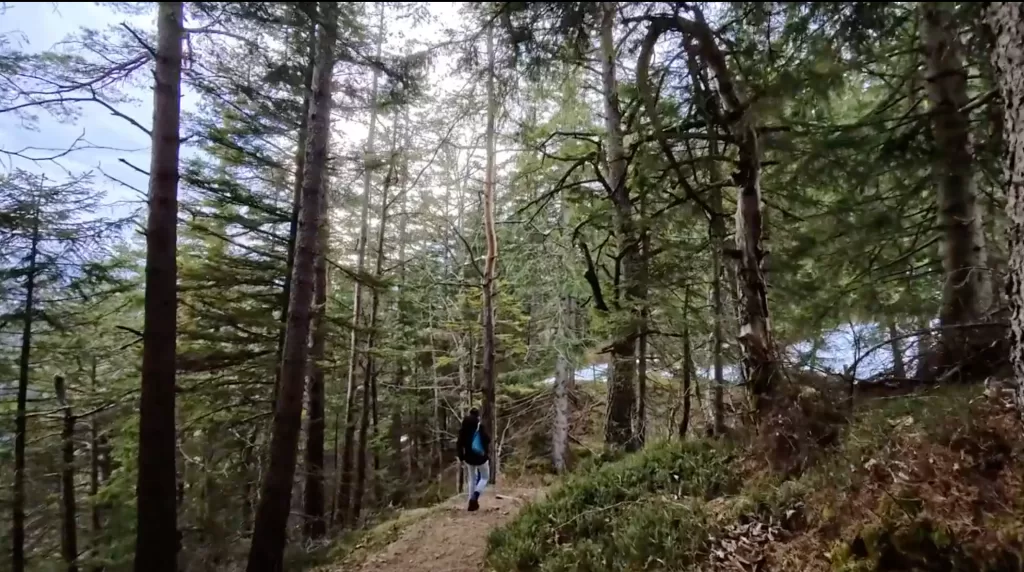
The trail zigzagged through pine forests with occasional clearings that teased views of the surrounding mountains. After about one and half hour or so of steady climbing (and me stopping to “take photos” when I actually needed to catch my breath), we emerged at a viewpoint that made every step worth it.
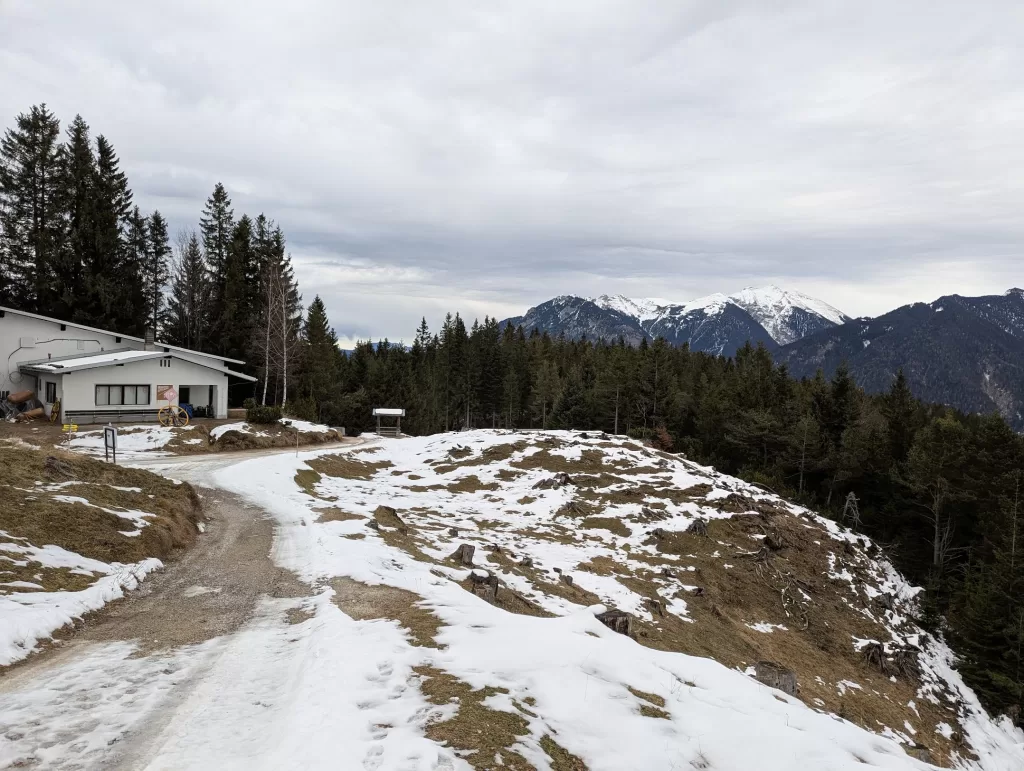
From the top of Hohen Kranzberg (at 1,391 meters), we were rewarded with a stunning panorama of the Karwendel range. The most exciting part was spotting Germany’s highest peak, the Zugspitze, in the distance, along with the distinctive shark-tooth shape of the Alpspitze. There’s something deeply satisfying about standing on one mountain and being able to name the others around you – like you’re slowly becoming friends with these ancient giants.

Unfortunately, our timing wasn’t perfect. The recent warm spell had melted much of the snow, leaving behind that awkward in-between winter landscape – not the pristine white wonderland of deep winter nor the vibrant green of spring. Still, the mountains themselves were magnificent, their rocky peaks dusted with persistent snow against the backdrop of a moody sky.
Lautersee and Lainbachschlucht
After enjoying a small snack at the top (because food always tastes better when you’ve worked for it), we began our descent toward Lautersee. The lake wasn’t looking its best with the melting snow creating muddy patches around its edges, but I could easily imagine how beautiful it must be in summer, reflecting the surrounding peaks like a mirror.
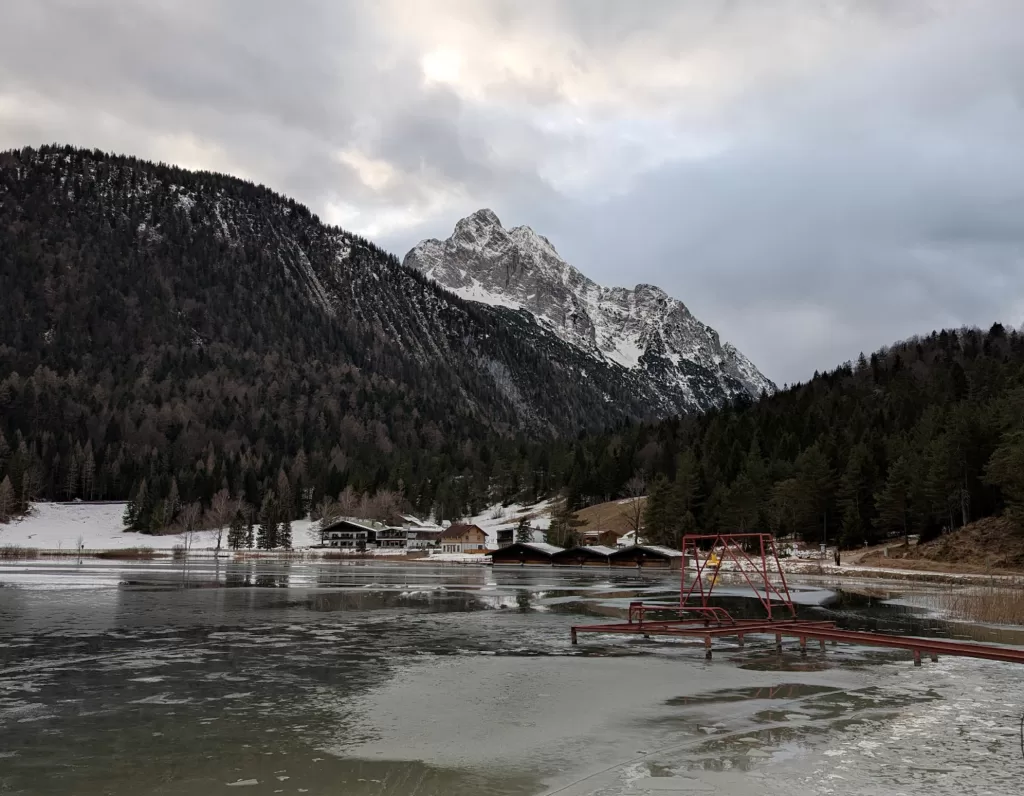
The real highlight of our descent was the Lainbachschlucht (Lainbach Gorge). The path narrows dramatically here, with walkways built directly into the cliff face alongside a waterfall. Water has carved its way through the rock over centuries, creating a dramatic gorge that’s both beautiful and slightly intimidating. The metal walkways cling to the rock walls, and you can feel the spray from the waterfall as you make your way down. At several points, I pressed myself against the mountain side, not because it was actually dangerous (the barriers are very secure), but because the drop was enough to trigger my mild fear of heights.
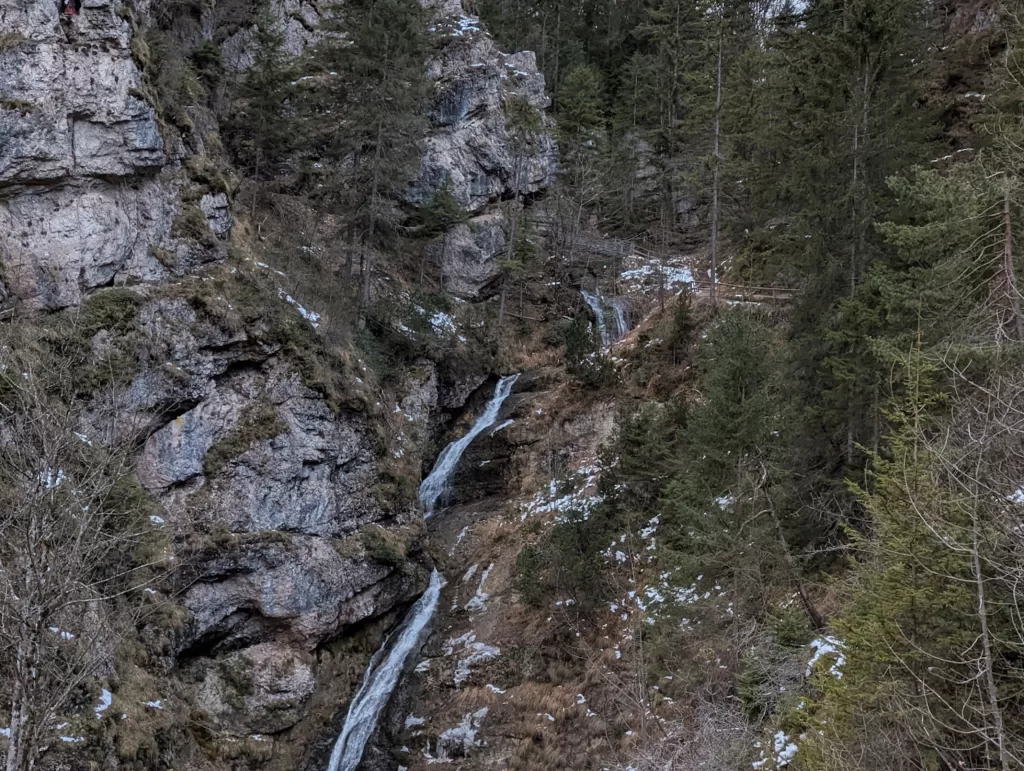
Gentler Paths: Klais to Krün Circuit
For our second hiking day, we opted for something less vertical. The Klais, Sonnenhügel, Grubsee route promised a more relaxed experience, traversing forests and small villages rather than scaling peaks.
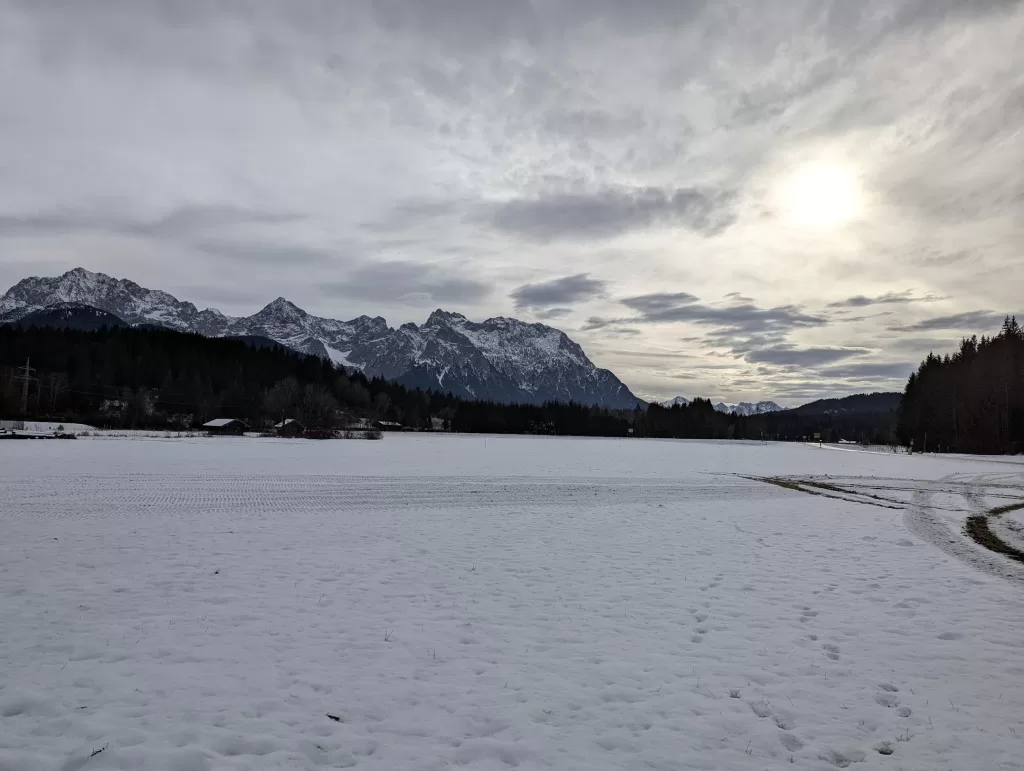
We took the train to Klais, a tiny settlement that consists of little more than a train station and a handful of houses. The morning was crisp but bright, with clouds playing hide-and-seek with the sun. As we set off into the forest, I was struck by how peaceful everything was – the only sounds were our footsteps on the partially snow-covered path and the occasional bird call.
The forest trail was like something from a Brothers Grimm tale – tall pines creating natural corridors, patches of melting snow revealing moss-covered rocks underneath, and the occasional wooden bench placed at just the right spot for admiring a particular view. At one point, we walked through a perfect avenue of trees, their trunks creating a natural pathway that seemed to lead to another world.
Village Life in the Shadow of Giants
Eventually, the forest opened up to reveal wide meadows and the small village of Wallgau spread out below us. What strikes me about these Alpine villages is how they exist in such harmony with their dramatic surroundings. The traditional Bavarian houses with their wooden balconies and painted facades seem to grow naturally from the landscape, just as the mountains do.
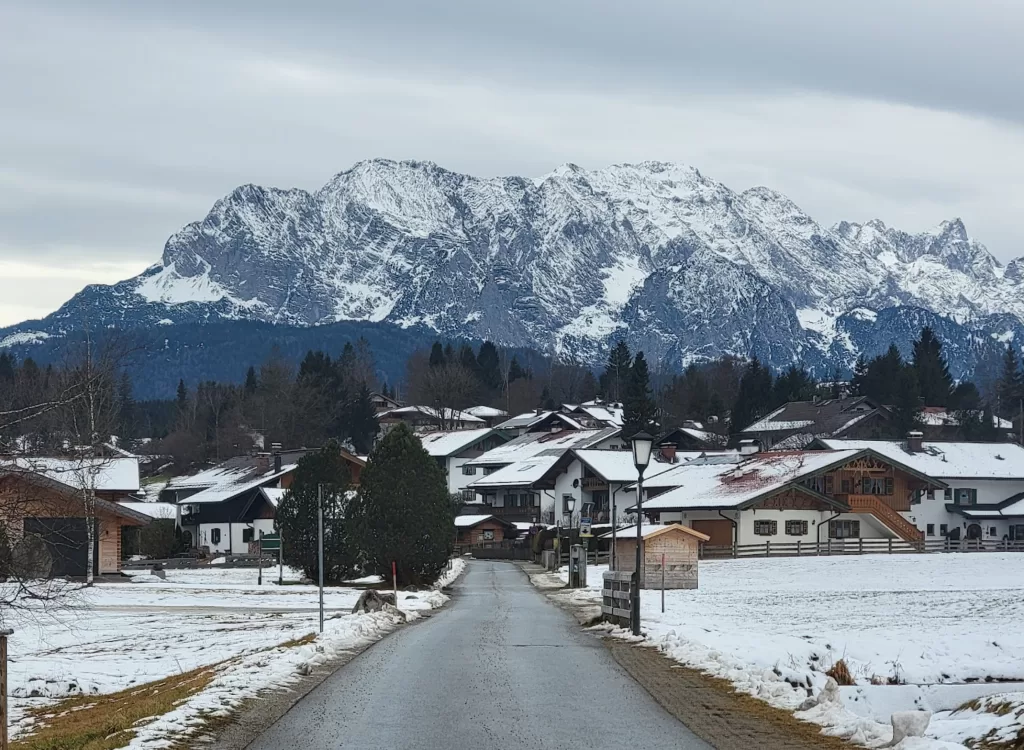
We continued on to Krün, another small village that embodies the peaceful Alpine lifestyle. Walking through these communities makes me temporarily fantasy about giving up city life for mountain simplicity. People were going about their daily business – an elderly man chopping wood, children playing in a garden, someone delivering mail – all with the majestic backdrop of snow-capped peaks that would have tourists like me stopping for photos every five minutes.
The casual way locals treat these views – as just the ordinary backdrop to their everyday lives – always amuses me. I imagine they must think tourists are strange, getting so excited about mountains that have always been there.
Walking in Roman Footsteps
On our return journey to Klais, we took a slight detour that turned out to be my favorite part of the day. We found ourselves on the Original Via Raetia, also known locally as the Römerstraße (Roman Road). This ancient path was part of a Roman trade route that connected what is now Italy with the northern provinces across the Alps.
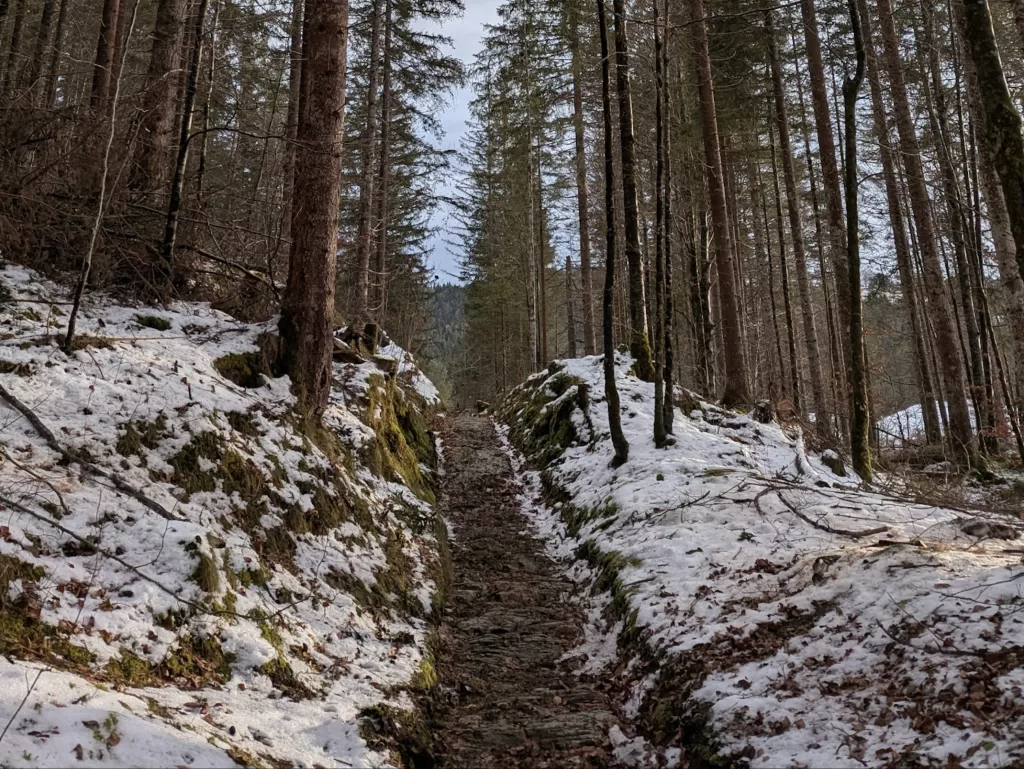
Walking on stones that might have been laid almost 2,000 years ago gave me a strange feeling of connection with the past. I tried to imagine Roman soldiers and merchants making their way through these same valleys, probably complaining about the weather or looking forward to the next inn, just as modern hikers do.
The Alpine Addiction

As we boarded the train back to Seefeld that evening, my legs were pleasantly tired from our day’s adventure. There’s something about the Alps that keeps pulling me back – the way they dominate the landscape, the endless variety of trails, the charming villages nestled in their valleys, and even the way the light changes on their faces throughout the day.
Each hike offers something different – whether it’s conquering a peak like Hohen Kranzberg for panoramic views, exploring dramatic gorges like the Lainbachschlucht, or walking ancient paths like the Via Raetia. The Mittenwald region packs all these experiences into a relatively small area, making it perfect for hikers who want variety without traveling great distances.
As we plan our next Alpine adventure, I’m already looking at maps and dreaming of trails not yet hiked. The mountains are calling, as they say, and I must go.
Alpine Trails and Roman Roads: Hiking Adventures in Mittenwald
During our winter stay in Seefeld, we couldn’t resist exploring the nearby Mittenwald region. With its picture-perfect town and network of hiking trails, it turned our vacation into a proper mountain adventure.

Mittenwald: Where Painted Houses Meet Mountain Peaks
Mittenwald is one of those towns that makes you wonder if you’ve somehow wandered onto a movie set. Nestled in the Bavarian Alps right by the Austrian border, this small German town is known for its beautifully painted houses (Lüftlmalerei) and violin-making tradition. But what caught my eye immediately were the mountains that seem to rise directly from the edges of town – they don’t gradually build up, they just BAM! shoot into the sky.

Our first hiking day started in the town center, where we grabbed some fresh pretzels for energy before heading toward Hohen Kranzberg.
The Climb to Hohen Kranzberg
The trail began innocently enough with a gentle forest path, but soon transformed into a proper mountain climb. As someone who grew up in flat urban environments, I’m still amazed at how locals casually bike up these slopes that have me panting after five minutes.

The trail zigzagged through pine forests with occasional clearings that teased views of the surrounding mountains. After about one and half hour or so of steady climbing (and me stopping to “take photos” when I actually needed to catch my breath), we emerged at a viewpoint that made every step worth it.

From the top of Hohen Kranzberg (at 1,391 meters), we were rewarded with a stunning panorama of the Karwendel range. The most exciting part was spotting Germany’s highest peak, the Zugspitze, in the distance, along with the distinctive shark-tooth shape of the Alpspitze. There’s something deeply satisfying about standing on one mountain and being able to name the others around you – like you’re slowly becoming friends with these ancient giants.

Unfortunately, our timing wasn’t perfect. The recent warm spell had melted much of the snow, leaving behind that awkward in-between winter landscape – not the pristine white wonderland of deep winter nor the vibrant green of spring. Still, the mountains themselves were magnificent, their rocky peaks dusted with persistent snow against the backdrop of a moody sky.
Lautersee and Lainbachschlucht
After enjoying a small snack at the top (because food always tastes better when you’ve worked for it), we began our descent toward Lautersee. The lake wasn’t looking its best with the melting snow creating muddy patches around its edges, but I could easily imagine how beautiful it must be in summer, reflecting the surrounding peaks like a mirror.

The real highlight of our descent was the Lainbachschlucht (Lainbach Gorge). The path narrows dramatically here, with walkways built directly into the cliff face alongside a waterfall. Water has carved its way through the rock over centuries, creating a dramatic gorge that’s both beautiful and slightly intimidating. The metal walkways cling to the rock walls, and you can feel the spray from the waterfall as you make your way down. At several points, I pressed myself against the mountain side, not because it was actually dangerous (the barriers are very secure), but because the drop was enough to trigger my mild fear of heights.

Gentler Paths: Klais to Krün Circuit
For our second hiking day, we opted for something less vertical. The Klais, Sonnenhügel, Grubsee route promised a more relaxed experience, traversing forests and small villages rather than scaling peaks.

We took the train to Klais, a tiny settlement that consists of little more than a train station and a handful of houses. The morning was crisp but bright, with clouds playing hide-and-seek with the sun. As we set off into the forest, I was struck by how peaceful everything was – the only sounds were our footsteps on the partially snow-covered path and the occasional bird call.
The forest trail was like something from a Brothers Grimm tale – tall pines creating natural corridors, patches of melting snow revealing moss-covered rocks underneath, and the occasional wooden bench placed at just the right spot for admiring a particular view. At one point, we walked through a perfect avenue of trees, their trunks creating a natural pathway that seemed to lead to another world.
Village Life in the Shadow of Giants
Eventually, the forest opened up to reveal wide meadows and the small village of Wallgau spread out below us. What strikes me about these Alpine villages is how they exist in such harmony with their dramatic surroundings. The traditional Bavarian houses with their wooden balconies and painted facades seem to grow naturally from the landscape, just as the mountains do.

We continued on to Krün, another small village that embodies the peaceful Alpine lifestyle. Walking through these communities makes me temporarily fantasy about giving up city life for mountain simplicity. People were going about their daily business – an elderly man chopping wood, children playing in a garden, someone delivering mail – all with the majestic backdrop of snow-capped peaks that would have tourists like me stopping for photos every five minutes.
The casual way locals treat these views – as just the ordinary backdrop to their everyday lives – always amuses me. I imagine they must think tourists are strange, getting so excited about mountains that have always been there.
Walking in Roman Footsteps
On our return journey to Klais, we took a slight detour that turned out to be my favorite part of the day. We found ourselves on the Original Via Raetia, also known locally as the Römerstraße (Roman Road). This ancient path was part of a Roman trade route that connected what is now Italy with the northern provinces across the Alps.

Walking on stones that might have been laid almost 2,000 years ago gave me a strange feeling of connection with the past. I tried to imagine Roman soldiers and merchants making their way through these same valleys, probably complaining about the weather or looking forward to the next inn, just as modern hikers do.
The Alpine Addiction

As we boarded the train back to Seefeld that evening, my legs were pleasantly tired from our day’s adventure. There’s something about the Alps that keeps pulling me back – the way they dominate the landscape, the endless variety of trails, the charming villages nestled in their valleys, and even the way the light changes on their faces throughout the day.
Each hike offers something different – whether it’s conquering a peak like Hohen Kranzberg for panoramic views, exploring dramatic gorges like the Lainbachschlucht, or walking ancient paths like the Via Raetia. The Mittenwald region packs all these experiences into a relatively small area, making it perfect for hikers who want variety without traveling great distances.
As we plan our next Alpine adventure, I’m already looking at maps and dreaming of trails not yet hiked. The mountains are calling, as they say, and I must go.